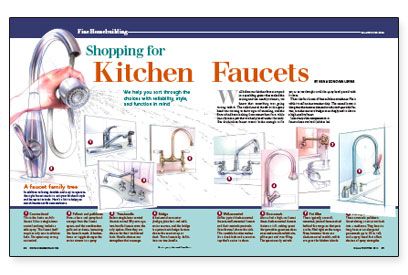Shopping for Kitchen Faucets
We help you sort through the choices with reliability, style, and function in mind.

Synopsis: A kitchen and bath designer provides an in-depth look at kitchen faucets, offering an insider’s look at the various types, finishes, and accessories available, from the conventional single-lever faucet to high-priced faucets with accessories such as water filters. A few gee-whiz faucets are featured, along with a list of faucet manufacturers.
Well before our kitchen faucet erupted in a sparkling geyser that soaked the ceiling and the nearby cabinets, we knew that something was going wrong with it. The coiled-metal sheath at the spray head was starting to show signs of uncoiling, and the fixture had been leaking from somewhere for a while (mostly into a pot that we had placed under the sink). But the kitchen faucet wasn’t broke enough to fix yet, or so we thought until the spray head parted with its hose.
That’s the first lesson of faucet-failure avoidance: Fix it while it’s still an inconvenient drip. The second lesson is that given the constant demands on this indispensable fixture, it makes sense to budget accordingly and to choose a high-quality faucet.
Like every other component in a contemporary kitchen, faucets have evolved. They now have more shapes, styles, finishes, and functions than ever. So before you make a choice, familiarize yourself with the types of faucets on the market.
The most reliable faucets have ceramic innards
Beneath their metallic skins, most types of modern kitchen faucets contain a plastic cartridge housing a pair of ceramic disks that regulate water flow. Each disk has holes in it. Turning the faucet’s handle slides the disks over one another. When the holes line up, water flows through the cartridge and the faucet. Turning the faucet off moves the holes out of alignment, halting the flow.
Ceramic disks are second only to diamonds in hardness, which is why they are ideal for this job. If there is any grit or debris in the water, the disks grind it up and remain unscathed. Gritty water can damage other types of valves.
The disks are fired at over 2000°F; therefore, the hottest tap water cannot damage them. The disk faces are so highly polished that they stick to each other as if magnetized. The higher the polish, the smoother they glide, and the smoother the faucet handle operates. Smooth operation increases minute control over volume and temperature and requires less user effort. There are other types of valves that regulate water flow in faucets, but ceramic-disk technology is state of the art.
Buying a faucet with a first-rate cartridge doesn’t mean that you have to squander the budget. Basic models sell for around $80 to $120, depending on the spray attachment.
Look for brass or stainless steel
Top-quality faucets possess both inner and outer beauty. The best ones are made of either solid brass or stainless steel. Both of these metals can stand up to high pressure, high temperatures, and potentially corrosive minerals in the water supply.
In the world of brass faucets, be sure to shop for one that is made of cast, not tubular, brass. Cast-brass faucets are thicker and longer-lasting than their tubular cousins.
For more photos, illustrations, and details, click the View PDF button below:
Fine Homebuilding Recommended Products
Fine Homebuilding receives a commission for items purchased through links on this site, including Amazon Associates and other affiliate advertising programs.

A Field Guide to American Houses

A House Needs to Breathe...Or Does It?: An Introduction to Building Science

All New Bathroom Ideas that Work

























